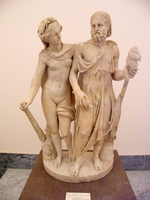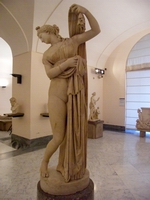Indice dei Musei
presenti in miti3000
Napoli Museo Nazionale - Piano Terra - Collezione Farnese - sala XXV
Testo
Posiziona il mouse sulle immagini per avere informazioni.
|
|
Trapezoforo
inv. 6672 Metà II secolo d.C.
Il sostegno di tavolo, trasferito a Napoli da Villa Madama, presenta numerosi interventi di restauro di Carlo Albacini. La decorazione scultorea si sviluppa a tutto tondo in corrispondenza della parte anteriore della transenna, delimitata in alto e in basso da cornici modanate, mentre è resa ad alto rilievo sulle facciate laterali. Ad una estremità è rappresentato è il mito omerico di Scilla che ghermisce i compagni di Ulisse. Il mostro marino dal corpo di donna, con il braccio destro scompostamente portato sulla testa, avvolge con le spire della sua coda pisciforme il corpo esamine di un uomo, mentre le tre teste di cane che si dipartono dal suo ventre fanno scempio di altri naufraghi che si dibattono tra le onde. Sull'altro lato è rappresentato un centauro, con nebride scossa dal vento, siringa nella mano sinistra e un piccolo erote seduto sulla sua groppa; sopra di lui si riconosce un'aquila che stringe tra gli artigli un serpente.
Il trapezoforo, la cui decorazione presenta elementi di confronto con il noto gruppo di Scilla rinvenuto nella Grotta di Tiberio a Sperlonga, si può datare attorno alla metà del II secolo d.C.
Trapezoforo (table support)
inv. 6672 Mid-2nd century AD
This table support was transferred to Naples from the Villa Madama and was the subject of numerous restorations by Carlo Albacini.
The sculptural decoration is developed completely in the round on the frontal part of the screen, bounded at top and bottom by moulded cornices, while on the sides it is carved in high relief. On it is depicted the Homeric myth of Scylla gripping Ulysses' sailors. The sea-monster that emerges from the woman's body, her arm thrown haphazardly over her head, encircles in the loops of her fish-like tail the lifeless body of a man. Meanwhile the three dogs' heads that emerge from her stomach wreak destruction on other shipwrecked sailors who struggle in the waves. A centaur is depicted on the opposite side, her nebride moving in the wind, a reed in her left hand and a small cupid seated on her back. Above her is an eagle holding a snake in its talons.
This table support, whose decoration can be compared with the famous Scylla group found in the Grotto of Tiberius at Sperlonga, can be dated around the middle of the 2nd century AD.
Venere Callipige
inv. 6020, copia romana, della prima metà del II sec. d.C., da originale greco variamente datato al III o al II sec. d.C..
Prima del suo trasferimento alla Farnesina, la celebre Venere Callipige costituiva un gruppo con le due Veneri accovacciate (inv. 6293 e 6297) sistemate a Palazzo nella "Sala dei filosofi", che evidentemente fungeva da provocatorio contrasto con i severi ritratti di filosofi e letterati. La fanciulla scopre le sue nudità con studiato effetto tra la levigatezza del corpo e la pesante ricaduta del panneggio; benché abbia subito consistenti interventi di restauro (tutta la parte superiore, il braccio sinistro, la mano e la gamba destra sono moderni), la composizione è rimasta sostanzialmente inalterata restituendoci i caratteri salienti di una creazione ellenistica di controversa interpretazione sia per quanto tiguarda il soggetto raffigurato (Afrodite, etera o danzatrice), sia per quanto riguarda la sua collocazione cronologica (III o II sec. a.C.) e geografica (Magna Grecia o Asia Minore).
Venus Kallipygos
inv. 6020 - Roman copy, from the first half of the 2nd century AD, from a Greek original dated to the 3rd century AD.
Before it was taken to the Farnesina, the famous Venus Kallipygos was part of a group of two crouching Venuses (inv. 6293 and 6297) located in the 'Hall of the Philosophers' in the Palazzo, evidently acting in provocative contrast to the severe portraits of philosophers and men of literature. The young girl uncovers her nudity with a deliberate effect created by the softness of her body and the heavy fall of her drapery. Although it as been subject to much restoration (the whole upper part, left arm, right hand and right leg are modern), the composition of the statue remains substantially unaltered. Handed down to us are the key features of a Hellenistic creation, but its interpretation is controversial, in terms of the subject it represents (Aphrodite, an heteira or a dancer) its date (3rd or 2nd century BC) and its geographical origin (Magna Grecia or Asia Minor).





